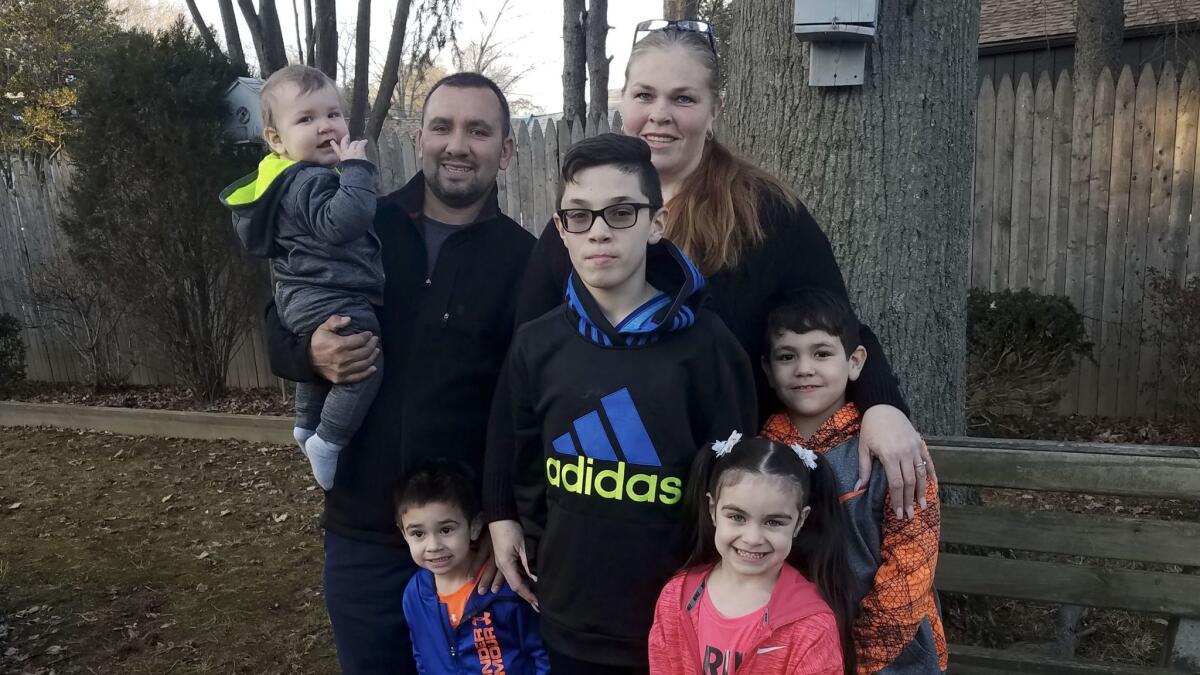For some immigrants, a wrenching dilemma: Stay or leave?

Reporting from Washington — When the Trump administration decided to end protected status for people from El Salvador, Hector Soriano faced a wrenching decision and a big gamble.
In the 17 years since he gained protection from deportation — giving him the right to work legally in the U.S. — Soriano established a successful landscaping business and fathered four young children, all U.S. citizens. Recently, Soriano, 42, and his fiancee, Jennifer Carlsen, moved up their wedding plans, knowing that marriage to a U.S. citizen generally provides a sure path to legal status for immigrants.
But because Soriano first came to the U.S. illegally, in 1999, immigration law says he will have to return to El Salvador before he can apply for a green card.
“If it wasn’t for that, I would have done it a long time ago,” said Soriano, of Bensalem, Pa., outside Philadelphia. “The reason I didn’t do it — if I had to leave the country, I was afraid they wouldn’t let me back in. I can’t afford to leave her, and leave my kids.”
If Soriano lived in California or Ohio, however, he would not face that decision. In 13 states covered by the U.S. 6th and 9th Circuit Courts of Appeals, including the entire West Coast, courts have ruled that someone in Soriano’s situation can apply for a green card without leaving the U.S.
The judges in those courts have ruled that having so-called temporary protected status, or TPS, counts as a “legal entry” — usually a necessary first step toward applying for legal status.
That’s just one example of the complexity of immigration law that hundreds of thousands of immigrants now must navigate as the Trump administration winds down programs that have allowed them to live and work legally in the U.S.
All told, the administration has announced plans to terminate federal protections that have covered roughly 1 million immigrants, including TPS and the Deferred Action for Childhood Arrivals program.
“Unfortunately, that’s one indication of our broken immigration system, where the system doesn’t make a whole lot of sense,” said Nick Katz, a lawyer with CASA de Maryland, an immigration advocacy group based in Tacoma Park, Md. “There’s not a whole lot of consistency across the board.”
The approaching end of temporary protected status for people who came to the U.S. from El Salvador, Haiti and Nicaragua affects more than 300,000 people and has led to lots of agonized kitchen-table conversations.
Immigration lawyers are getting calls with tough questions: Should I leave now and apply for a visa? What are the odds, in the Trump era, that I will be allowed to come back? Or should I stay and take my chances as an undocumented immigrant?
Moving his family to El Salvador is not an option, Soriano said.
“If my country was a different country, if you could live without having to fear one of our kids getting killed by something stupid, I would say, of course,” he said. “The way things are in El Salvador, you can’t afford to do that.”
In a briefing with reporters this month about the end of temporary status for Salvadorans, an administration official declined to offer advice to immigrants with families, saying only that U.S. Citizenship and Immigration Services will consider cases on their merits.
“We’re not getting involved in individual family decisions,” he said. The official briefed reporters on condition of anonymity.
President Trump has been determined to wind down TPS, the special protection from deportation that is granted under immigration law for people from countries hard hit by natural disasters and civil wars. Salvadorans got the protection after two massive earthquakes in 2001, and the country’s continuing problems led successive administrations to renew the program 11 times.
Under Trump, the Department of Homeland Security has taken a stricter approach, but has given affected people as much as 18 months to prepare. The TPS designation for El Salvador will expire in November 2019. Protections for some 59,000 Haitians expire in July 2019. Both groups of protected immigrants must apply by March 18 to extend their protections until the new expiration dates.
About 5,000 Nicaraguans, who will lose TPS in January 2019, must apply for an extension by Feb. 13.
In ending the protections, administration officials noted that Congress could pass a law allowing longtime TPS holders to stay. Democrats have introduced bills to do that, and senators discussed including such a provision in the deal to protect the so-called Dreamers.
But Trump ripped that idea at a White House meeting last week, saying he didn’t want more people coming to the U.S. from “shithole countries,” according to participants in the meeting. Trump and some Republicans have denied he used that vulgarity, with some White House officials suggesting that he may have said “shithouse.”
After the current protections end, immigration advocates say many of those who have been covered by TPS will have limited options; unlike Soriano, many don’t have a good route to become legal residents of the U.S. Over the years, Salvadorans covered by TPS have become parents of nearly 200,000 U.S. citizen children, studies have found.
“Probably the majority of people living under TPS will either go underground or go back to their home countries,” said Andrew Cohen, an immigration lawyer in Los Angeles. For a lot of people, however, returning to their country of origin “is not a viable option, because they’re the breadwinner of an extended family here,” he said.
Those in the best position are people who have a U.S. citizen spouse or other close family member and live in a state covered by the 9th or 6th Circuit.
Last March, the 9th Circuit held that Jesus Ramirez — a Salvadoran who had entered the U.S. illegally in 1999, received temporary protected status and married a U.S. citizen — could stay in the U.S. while applying to become a permanent resident. That decision echoed a similar one by the 6th Circuit in 2013.
9th Circuit decisions apply in California and eight other Western states: Alaska, Arizona, Hawaii, Idaho, Montana, Nevada, Oregon and Washington.
The 6th Circuit covers Kentucky, Michigan, Ohio and Tennessee.
Another appellate court, covering Florida, Georgia and Alabama, made an opposite ruling.
In states not covered by the two rulings, the choice to leave the U.S. and seek a green card is a risky one, said David Leopold, an immigration lawyer from Cleveland.
“People who seek a green card need to think long and hard before they depart the U.S., expecting to be permitted back in with a waiver,” Leopold said.
So far, the immigration service has been treating applications according to the rules that apply in each state. There’s nothing in the rules that says a TPS holder can’t move to another state and make the application from there, a spokeswoman said.
Soriano and Carlsen have thought about that option, but it would require him to give up his business and the 120 clients he’s gathered through years of work. “It’s a really hard predicament,” Carlsen said. “If it came right down to it, we’d have to do whatever was necessary to keep our family together.”
The whims of the quirky system are not lost on them. “We border Ohio,” Carlsen says. “It’s right there. It’s so frustrating.”
Twitter: @jtanfani
More to Read
Get the L.A. Times Politics newsletter
Deeply reported insights into legislation, politics and policy from Sacramento, Washington and beyond. In your inbox three times per week.
You may occasionally receive promotional content from the Los Angeles Times.











